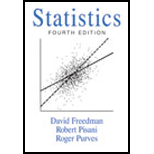
(a)
Delineate whether the question makes sense.
(a)
Answer to Problem 8RE
The question does not make sense.
Explanation of Solution
In this scenario, 50% of the women aged 16 years and older in Country U were employed in the year 1985 and 59% of the women 16 and older in the year 2005.
Based on the given information, the following values are known:
The question of statistically significant difference in percentages only makes sense when the sample is a probability sample.
On observing the given information, the sample is not known to be a probability sample, as the sample could contain all individuals in the population, and thus, the individuals were not selected from the population by chance. Therefore, this implies that the question does not make sense.
(b)
Delineate whether the information provided makes sense.
(b)
Answer to Problem 8RE
The information provided does not make sense.
Explanation of Solution
It is known from the results in Part (b) that the question does not make sense. In this context, it is known whether the samples are simple random samples.
This is not appropriate to answer the question as long as whether or not the samples are simple random samples.
(c)
State whether the difference in percentages is statistically significant if it is assumed that the Current Population Survey was based on independent simple random samples in each year of 50,000 women aged 16 years and older.
(c)
Answer to Problem 8RE
There is enough evidence that the difference in percentages is statistically significant.
Explanation of Solution
The box corresponding to 1985 data contains a ticket per woman, where the value on the ticket is a 1, when she is employed. Otherwise, the value on the ticket is 0.
The box corresponding to 2005 data contains a ticket per woman, where the value on the ticket is a 1, when she is employed. Otherwise, the value on the ticket is 0.
The test hypotheses are given below:
Let
Null hypothesis:
That is, the percentages of the two boxes are the same.
Alternative hypothesis:
That is, the percentages of the two boxes are different.
The standard deviation A is given below:
The standard error of Box A is given below:
The standard error A of the average is the standard error of the sum divided by the number of draws as given below:
The standard deviation B is given below:
The standard error of Box B is given below:
The standard error B of the average is the standard error of the sum divided by the number of draws as given below:
The standard error for the difference is shown below:
The formula for test statistic is as follows:
Known values:
The observed value, x is given below:
The z-score is obtained as given below:
The P-value is given below:
Using the Standard normal table, the value corresponding to
Remaining calculation:
Since the P-value is less than any of level of significance, it is unusual to obtain a difference in sample percentages of 9% when there is no difference in the population percentages, and thus, the difference does not appear to be due to chance variation.
Therefore, this implies that the difference in percentages is statistically significant.
Want to see more full solutions like this?
Chapter 29 Solutions
Statistics
 MATLAB: An Introduction with ApplicationsStatisticsISBN:9781119256830Author:Amos GilatPublisher:John Wiley & Sons Inc
MATLAB: An Introduction with ApplicationsStatisticsISBN:9781119256830Author:Amos GilatPublisher:John Wiley & Sons Inc Probability and Statistics for Engineering and th...StatisticsISBN:9781305251809Author:Jay L. DevorePublisher:Cengage Learning
Probability and Statistics for Engineering and th...StatisticsISBN:9781305251809Author:Jay L. DevorePublisher:Cengage Learning Statistics for The Behavioral Sciences (MindTap C...StatisticsISBN:9781305504912Author:Frederick J Gravetter, Larry B. WallnauPublisher:Cengage Learning
Statistics for The Behavioral Sciences (MindTap C...StatisticsISBN:9781305504912Author:Frederick J Gravetter, Larry B. WallnauPublisher:Cengage Learning Elementary Statistics: Picturing the World (7th E...StatisticsISBN:9780134683416Author:Ron Larson, Betsy FarberPublisher:PEARSON
Elementary Statistics: Picturing the World (7th E...StatisticsISBN:9780134683416Author:Ron Larson, Betsy FarberPublisher:PEARSON The Basic Practice of StatisticsStatisticsISBN:9781319042578Author:David S. Moore, William I. Notz, Michael A. FlignerPublisher:W. H. Freeman
The Basic Practice of StatisticsStatisticsISBN:9781319042578Author:David S. Moore, William I. Notz, Michael A. FlignerPublisher:W. H. Freeman Introduction to the Practice of StatisticsStatisticsISBN:9781319013387Author:David S. Moore, George P. McCabe, Bruce A. CraigPublisher:W. H. Freeman
Introduction to the Practice of StatisticsStatisticsISBN:9781319013387Author:David S. Moore, George P. McCabe, Bruce A. CraigPublisher:W. H. Freeman





